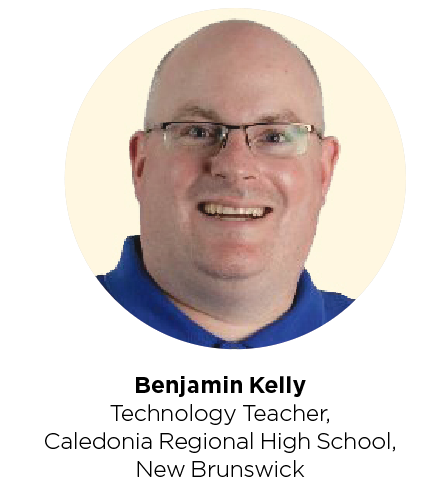Sponsored by:

Innovation and Education at Microsoft Canada
Continuing studies Microsoft has recognized a gap in the Canadian education system in providing students workshops to learn tech skills including coding, AI, and STEM.
.jpg)
 Kevin Peesker, CEO of Microsoft Canada, speaks to how Microsoft is setting the tone for the future of Canada’s digital economy.
Kevin Peesker, CEO of Microsoft Canada, speaks to how Microsoft is setting the tone for the future of Canada’s digital economy.
Technology looks to be a key driver of Canada’s future growth and educating talent pools should pay dividends for innovating the digital economy.
Despite the optimism, Canada’s readiness for disruption via artificial intelligence (AI) shows room for improvement. A study by McKinsey & Company found 89 percent of Canadian business leaders believe it will create major positive change in three to five years, yet only 34 percent have adjusted their long-term strategies to see AI’s potential benefits.
Teaching the right tech skills today is crucial to positioning the workforce to thrive in tomorrow’s evolving landscape.
“Canada’s tech industry must work closely with academia and policymakers to ensure that Canadian tech talent can compete on a global scale,” says Kevin Peesker, CEO at Microsoft Canada. “We see Montreal as the epicentre of deep learning engineering and research. In B.C., we are actively supporting the Cascadia Innovation Corridor which opens collaboration and economic development opportunities between Vancouver and Seattle.”
Customers and partners emerging from the country also vary across industries, with agriculture, retail, healthcare, and tech organizations ultimately enabled by AI innovation.
Reaching out
To follow through with the commitment to securing Canada’s digital future, Peesker believes the focus should go beyond the next five years. Learning how to code is beginning to form the backbone of this process, although most students aren’t finding the opportunity to do so in their schools.
“In schools across the country, we have an incredible network of educators that are supporting our mission and bringing technology and coding into the classroom,” he says. “Coding doesn’t just end in the classroom, and we have a great set of partners that help us scale STEM awareness to as many young people as we can. Only one in 10 young Canadians reports participating in coding or programming activity outside of school.”
Peesker says the company has reached over 56,000 young people, 50 percent of whom were girls and 80 percent underserved and Indigenous youth. Microsoft has worked with partners travelling cross-country offering workshops, while the company’s stores are also holding STEM workshops of their own for children, parents and teachers.
“We have an obligation as technology leaders to equip Canadian youth and STEM professionals with an evolving set of digital skills — but we need the entire community to come together to support this as well,” he says.
Advanced AI Tech May Change Canadian Jobs for the Better
 Artificial intelligence (AI) is a common buzzword, yet it’s not widely understood publicly, despite the possibilities inherent in its vast potential, says John Weigelt, Microsoft Canada’s top tech executive.
Artificial intelligence (AI) is a common buzzword, yet it’s not widely understood publicly, despite the possibilities inherent in its vast potential, says John Weigelt, Microsoft Canada’s top tech executive.
As the National Technology Officer at Microsoft Canada, Weigelt believes AI is a broad term that encompasses sub-categories like machine learning, automation, and neural networks, among others. “There’s a need for the skills and ability to always be learning and understanding how these tools can impact the business or organization you’re in,” he says. “We don’t see AI replacing humans — we see it complementing humans and making them better.”
When opportunity knocks, who answers?
A physician working in tandem with AI can find a tumour with better accuracy. Self-driving trucks that give human operators more responsibility can act as brand ambassadors on the road through upselling and loss prevention. Weigelt equates these two examples as “repurposing” jobs with AI — similar to the expanded role tellers now play in banks, despite the presence of ATMs.
“We’re involved with four of the five super clusters where the federal government is investing $950 million in what’s next in technology,” says Weigelt. “We are trying to ecourage people to do something new or explore something new each day. We’re helping our customers — both individuals and businesses — understand how AI can help them."
The Information and Communications Technology Council (ICTC) projects there will be over 200,000 vacancies in digital talent alone, and Weigelt believes Canada has a unique position from an AI thought leadership perspective. “We see that transformation happening across the community, and there’s going to be a need to learn and understand these tools.”
How STEM Tools Bring Innovation to Life in the Classroom
 New, innovative technologies focused on STEM education are breathing new life into the classroom.
New, innovative technologies focused on STEM education are breathing new life into the classroom.
Kids have long been avid content consumers, but thanks to technology-inclusive classrooms, they’re also developing all the skills necessary to become dynamic content creators.
Teachers utilizing new technologies to enhance the STEM education experience are finding that enhanced learning comes with more engaged students. By learning skills like coding, robotics programming, and video game development, students build their own hands-on projects in the present, with a look toward the future. As an additional benefit, technology in the classroom supports a level playing field by providing access to tools that students would not have otherwise been able to experiment with at home.
“From a teacher’s point of view, we strive to have our kids be creators and makers instead of just consuming what someone else has made in another part of the world,” says Benjamin Kelly, a technology teacher at Caledonia Regional High School in New Brunswick. “If you put them into the water — they swim. By the time they hit grade nine, they’ve become legitimate game developers.”
Higher learning
Kelly cites Minecraft as a prime example of technology-derived learning due to the STEM lessons inherent in the popular game. Beyond game development, his students have been learning chemistry through it.
This is the mark of a different era. Whereas Microsoft Office applications like PowerPoint and Excel were hard sells in the past, students are now finding more inclusive and innovative tools in products like the Xbox and HoloLens. Coding language has only enhanced the existing robotics in class.
“I can now say I have a full-blown engineering program at my school because I have a HoloLens that allows us to do amazing things and bring them to life in the classroom,” says Kelly. “The whole purpose of school, in my mind, is to find kids’ passions and support them, so they can find a career that they love.”
^ Click to view larger


